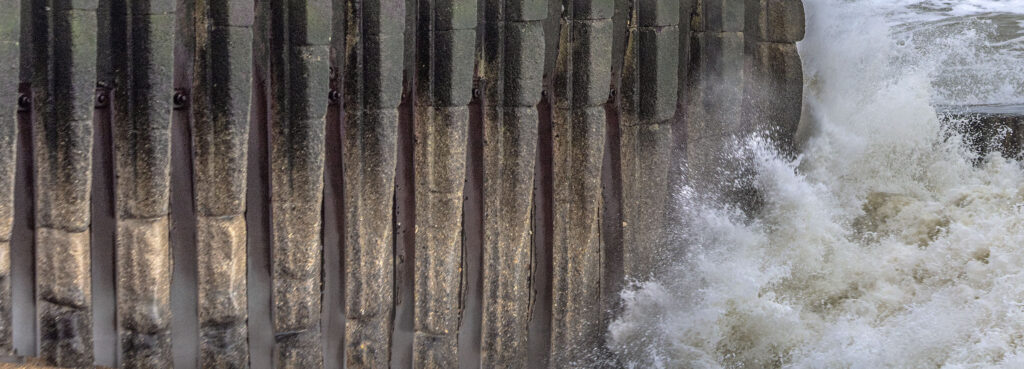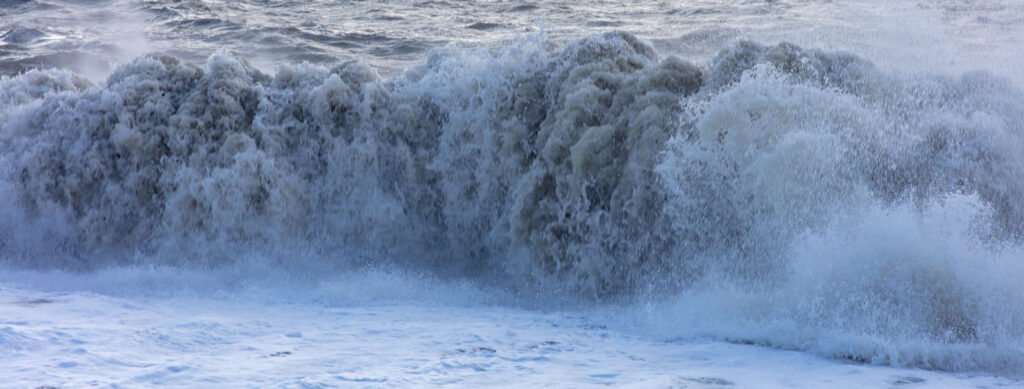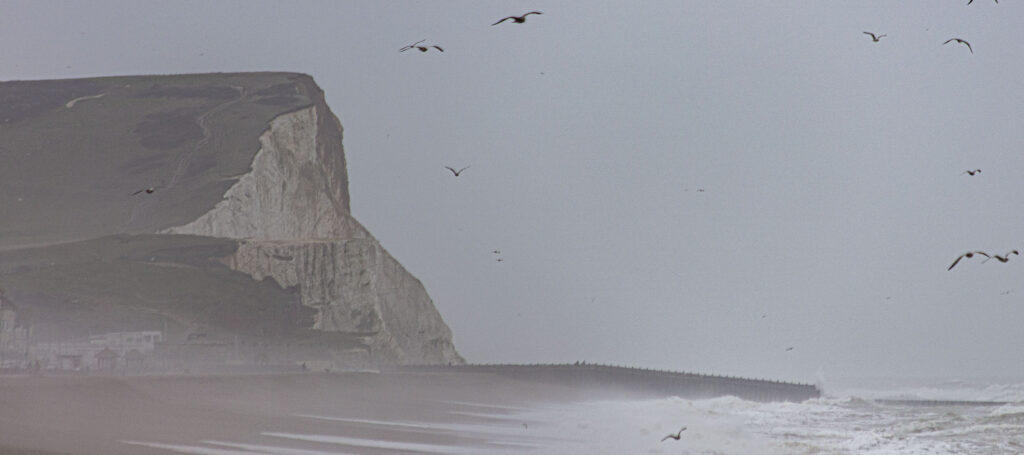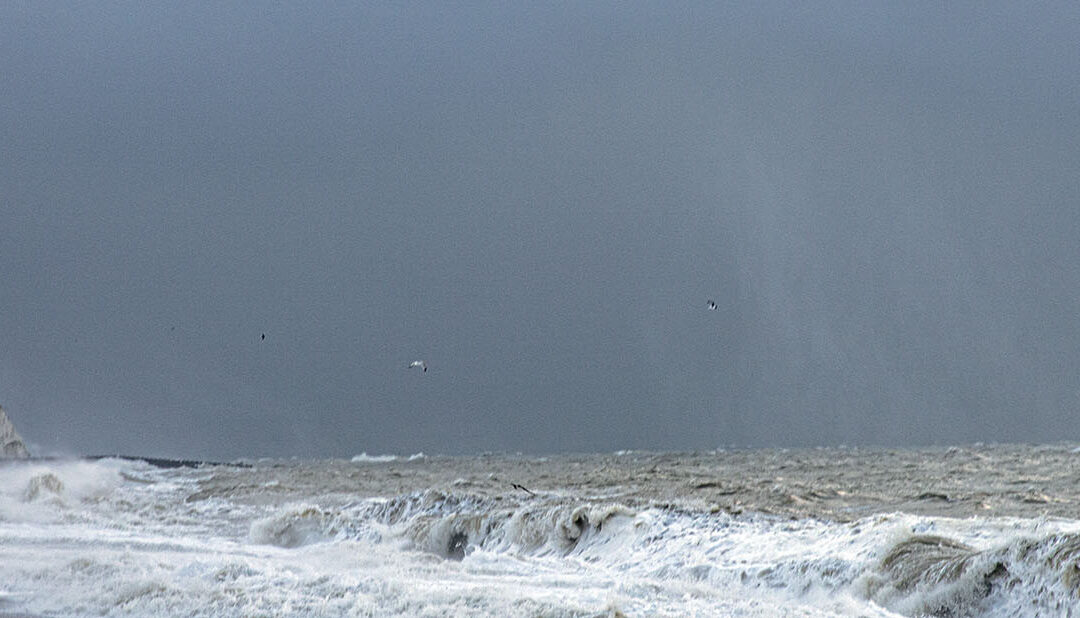Wind rattles a piece of loose guttering against the bargeboard on which its mounted, irregularly and irritatingly. The trees at the bottom of the garden angrily tap their branches together as the wind buffets them. It’s not a full-on gale; it’s probably only blowing at about 20 miles an hour but it’s enough to set up the rattle and roll of leaf and branch. The rain splatters against the windows, not the rat-a tat-tat it gives like gunfire in a full-on gale, but more the tapping of a gentle storm, not at all unusual here.
I snuggle under the duvet and remember when I once stood watch as a volunteer in the coast watch tower further along the coast. That day was a real storm, blowing hard, wind howling through the railings like a demented banshee as we climbed the steps to the tower. The old Coastguard station stands above the Palmerston Fort on the promontory guarding the entrance to Newhaven harbour. We let ourselves in to hear the rattle of the windows and to feel the tower shudder as the increasingly high winds buffeted it. No debate about raising the flag today, it would be gone in minutes.
We checked on the rapidly increasing wind speed recorded by the anemometer mounted on the roof. It was passing 50 knots and rising quickly (Coastguards measure in nautical knots not landlubber’s mph). The tower shook quite violently, and I wondered if the windows would hold. I asked one of the senior watchkeepers was there any advice given at what point it was dangerous to stay in very high winds? Apparently, there was no advice or ‘standing orders’ but we were all increasingly concerned.
There to assist civil authorities in maintaining the safety of small craft and beach goers along the seas and beaches of Seaford Bay and the Channel beyond, we relied on our anemometer for the wind speeds. It span rapidly on the roof above us as it supplied a continuous reading, showing the wind accelerating past 60 knots. The windows were rattling fiercely and the whole tower seemed to shudder with the blasts of the gale.
We could see little as the salt spray flew over the top of the Tower creating a fog of salt and sea, a ‘salt cloud’. The rain also limited visibility, but we were steadfast in being ready to do our watch until, with a loud bang, the anemometer parted company with the tower roof. The last recorded speed was over 67 knots. We decided discretion was, sensibly, the better part of valour.

The decay of the defences continues as waves laden with shingle and lumps of chalk batter the ‘pier’, stripping away the steel shuttering and fracturing the concrete beneath. This is the subject of my series of paintings I label ‘BRotS’
The constant almost daily frequency of spray over the town, 50 or 60 feet high blown as a coating onto windows and gardens, turning seaward-side leaves black, can kill gardens close to the shore. My own rowan tree refuses to grow higher than the garden wall, cowering down and turning into a rowan bush… Seaford town motto is ‘ E Ventis Vire’ or ‘strength from the winds’, probably chosen in the days of sail when men were men
This morning the wind is noisy and there is a major ‘amber’ storm warning from the Met office in place, yet the wind speed only seems to be gusting around 25knots. Of course the Met office is not manned by sailors with callused hands from heaving on ropes to control sails, but by soft University graduates living in a city where they rarely get weather, so a brisk wind may indeed appear worth a storm warning to them – and they now have happy colours to play with on their charts and amber is so bright isn’t it? So a superfluity of warnings, like boys excitedly crying wolf, now amplified by a berserkers siren on our mobile phones.
The house is well insulated, as seaside houses tend to be, and I listen as the wind moans past. With a click the heating system comes on. The click is the expansion of the long pipe under the bedroom floor that carries the hot water to the radiator. I listen to it ticking for a moment and the cat prods me – he knows it’s time for breakfast. I say prod and sometimes it is just that but often the ‘prod’ takes the form of planting all four feet firmly on whatever part of my body he can locate – the chest or an arm is OK, the tummy more irritating but just occasionally he ventures where no catspaw should go and gets an abrupt “gerroff!”, but he does wake me fully. The start of the morning routine is to open the curtains and assess the weather. Most days just a dressing gown, collect the camera and out into the garden but in a true storm I’ll throw on my clothes before venturing to the same spot I shoot from every day.
The Watchtower is manned from dawn to dusk all the year round, and a telephone call will have them giving wind speed and visibility along the coast quite happily. Support can be given through the various local events when they will have their stall, as National Coastwatch is a charity formed when our leaders in Westminster decided the coastguard service could work from a few large stations, robbing local communities, fishermen, surfers and the like of their ‘guardian angels’ on watch in their remote towers. Just another example of the contempt our rulers have for their people, preferring to give billions to corrupt regimes abroad rather then look after their own folk.
They could never stop the wind here despite their hedges of windmills sitting offshore. The cat joins me in my daily weather report, and so the national scales of windspeed and temperature now have an additional metrics, the SMI, or Soggy Moggy Index, ranging from 0 for dry to 9 for full sodden, soaked thoroughly wet. Look out for us on social media, and treat the alarmist global warming weather men with considerable caution as reality constantly contradicts their theatrics. The weather is not man made, the alarmism is.
For a proper scientific debunking of ‘man-made global warming’ read Prof. Ian Plimer, an Emeritus Professor of Earth Sciences book entitled ‘Green Murder’ published by Connor Court publishing


Recent Comments